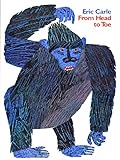Lesson 1: Using Picture Cues to Read Unknown Words
Lesson Plan
From Head to Toe | 80L

- Learning Goal
- Use picture cues to read unknown words.
- Duration
- Approximately 50 minutes
- Necessary Materials
- Provided: Independent Practice Worksheet
Not Provided: From Head to Toe by Eric Carle
-
Teacher Modeling

will explain that when we are reading, we may come to a word we do not know. We can use pictures to help us figure out the word. I will use From Head to Toe by Eric Carle (big book) to model how to use the pictures in a story to figure out unknown words. I will model using the pictures to figure out how to read the names of the first four animals in the book. For example, say: "The first picture shows an animal that is black and white and has flippers. I know that penguins are black and white and have flippers so maybe the first sentence says, 'I am a penguin.”' I can think about the word I don’t know by looking at the picture."
TIP: To easily model the strategy, use a big book. Before teaching the lesson, cover one word per page that can easily be determined by the picture cues.
-
Think Check
Ask: "How did I know the word was penguin?" Students should respond that you looked at the picture and thought about what would make sense.
-
Guided Practice

will use picture cues to figure out how to read the names of the animals in the rest of the story. We will discuss how the picture helped us figure out the challenging words in the book.
-
Independent Practice

will use pictures to read new vocabulary words for animals on the Independent Practice pages. Note: In order to accurately assess that students are using pictures to read unknown words, listen to each individual student read the sentence on each page of the Independent Practice. (Independent Practice is provided.)
Texts & Materials
Standards Alignment
(To see all of the ReadWorks lessons aligned to your standards, click here.)


An excellent resource! :) Thank you so much!
This site is wonderful, its helping so many children who have a hard time with comprehension.
Simply wonderful! Thank you for all that you do. I am going to spread the word to other teachers and utilize these helpful resources more often.
Thank you SO much! I will use this lesson with my Pre-K English language students tomorrow. We've already studied the spoken words for body parts, so this will help them make the connection to words on the page with the spoken word!
GREAT AND WELL PRESENTED WORK. THANKS
This is so helpful.
Thank you! This is so very, very helpful! I love it!!!
Excellent vocabulary lesson that I'll use in my ESL class! Thanks!
Awesome resource! Concrete activities and lesson to teach essetial skills for each grade level.
Great addition!! Thanks so much - love this lesson.
excellent resource..
Thank you for this cite I came across it at my point of need. Wanting to teach context clue and was not certain how, for young children. Thank you!
☺An excellent resource!☺